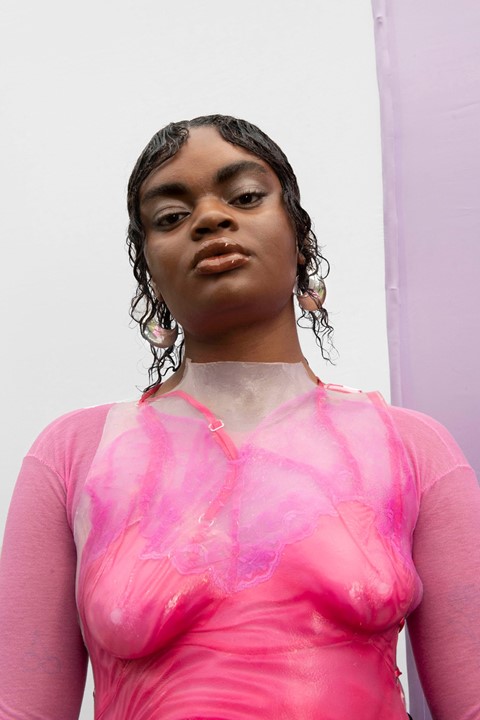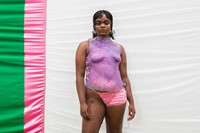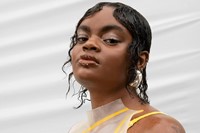Employing silicone, satin and silk, RCA graduate Sinéad O’Dwyer is making clothes for people traditionally excluded from mainstream fashion
- Who is it? Sinéad O’Dwyer, an Irish RCA graduate wanting to challenge fashion’s relationship to women’s bodies
- Why do I want it? Silicone pieces and ready-to-wear fit for any shape or size
- Where can I find it? To be confirmed
Who is it? If you were at the Royal College of Art graduate show last year, you would have seen seven models, lounging in acid- and pastel-hued silicone clothes, cast directly from women’s bodies. These pieces were the work of Sinéad O’Dwyer, an Ireland-born designer wanting to challenge fashion’s dysphoria-triggering visual culture. “As a teenager, I was always really obsessed with how people looked in the photos of the clothes, rather than with the clothes themselves,” O’Dwyer tells me. “Whenever I tried them on, I was desperately disappointed that I didn’t look like the pictures.” That feeling of failing to measure up to a prescribed ideal will be familiar to many, but O’Dwyer is keen to underscore that this ideal exists as much in the mind as it does on billboards and, through her practice as a fashion designer, dispel the notion that any woman’s body is not good enough.
Her graduate collection – titled 23:19:26 – was praised for its inclusive casting; her model line-up included women of sizes, shapes and ethnicities which have historically been excluded in mainstream fashion. But it went further than the casting, too: each piece was extruded from life-cast fibreglass moulds of the bodies of her two muses: Berivan Cemal Dalgali and Jade Bruce-Linton, the latter of who wore a lilac cast of herself at the show. For O’Dwyer, this was a statement against fashion’s obsession with industry-standard proportions and refusal to acknowledge or portray the changes a woman’s body goes through in her life. “It’s so ridiculous that the adult female body is always portrayed in one state. Even as a conventional-sized woman, you might get pregnant, you might get ill, you’ll go through menopause: there are so many transitions that women’s bodies go through in a lifetime,” she says. “The fact that it’s not depicted makes us live in fear of our bodies changing, of no longer living up to that ideal.”
O’Dwyer’s designs have already earned her popularity with women artists and performers in particular – Arca, Kelsey Lu, and choreographer Grace Nicol are among the names she’s worked with since graduating. “I love working with performers, it’s always such an amazing experience. That said, my work is very time consuming; it would be great to solely focus on this sort of work, but it’s really a matter of time!”

Why do I want it? Life-cast silicone pieces feature prominently in O’Dwyer’s Spring/Summer 2020 collection, Martina, captured here by Danish photographer Ottilie Landmark. Moulded from the body of her friend and muse Martina Dolcimascolo, these pieces sit alongside fully fashioned garments – shirred silk swimwear in sunshine yellow or duck-egg blue tops in printed mesh – rather than with the incidentally rippled satins of her graduate collection. As in previous work, the closures are cast in silver by silversmith Kevin O’Dwyer, with the addition of hand-cast eyelets for this season. The most significant development seen in her sophomore offering, however, is the arrival of ready-to-wear pieces to the designer’s universe.
While the focal point of her pieces was previously her subjects’ breasts, in this collection the viewer’s attention is drawn to their abdomens. “As I started embedding garments in the silicone pieces, I noticed that because Martina’s body shape has a smaller bust and a rounder stomach, the fabric was gathering between the breasts and the stomach was really coming into focus. I was then inspired to accentuate the stomach as a focal point for the nudity in my work, and translate that into a ready-to-wear context,” she says. In the future she’d like to make clothes for a broad cross-section of women, placing an emphasis on shirring and her particular take on bias-cutting to allow for ample stretch. “I was really interested in diagonal lines, as the bias cut is typically thought of as the best for all body types. From there, I became obsessed with making dresses, tops and trousers by diagonally wrapping shirred silk straps around the body,” she says, resulting in the pieces composed of coiled rainbow bands.

Where her graduate work was fairly serious, Martina exhibits a breezy lightheartedness. “I was thinking about the experiences my friends and I have had of garments not fitting properly, and I wanted to approach that with a lighthearted touch. The last collection was quite heavy, but I think there’s so much humour to be found in clothes not fitting correctly.” Long-sleeved satin gowns that might otherwise pass for demure bunch up at the bust to reveal the stomach, while the ‘underboob bra’ was inspired by an initial experiment with embedding satin straps into the ‘Martina’ mould and snakes across the wearers’ chest like a bralet flipped upside-down.
Rather than simply ponder the tumultuous relationships between bodies and their clothing, O’Dwyer questions the logic that informs their making. “It’s too easy to take the same dress-form that people use each season. If you can’t translate your idea to size 24, is it really an interesting or relevant one? That said, my work isn’t just about being an unconventional size, whether that’s being bigger or smaller. It’s about giving a voice to the emotional experience of female oppression, and challenging the idea that we should always be striving to be something ‘better’,” she says.
Where can I find it? Stay tuned for stockists to be confirmed.






